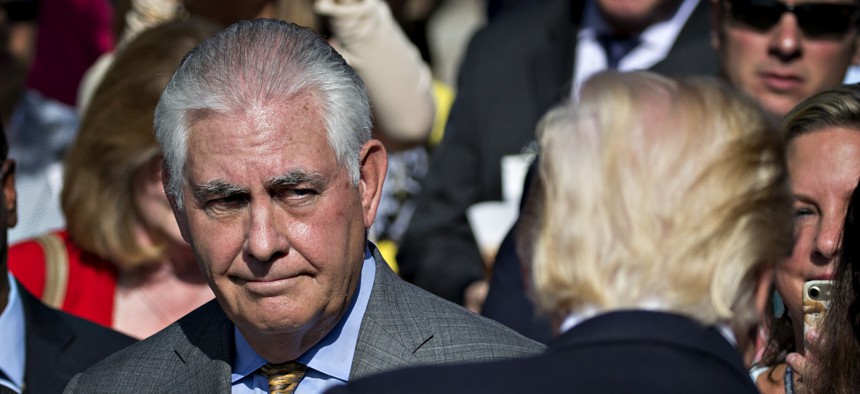
Then-Secretary of State Rex Tillerson, left, looks at U.S. President Donald J. Trump during a ceremony to commemorate the September 11, 2001 terrorist attacks, at the Pentagon in Washington, D.C., on Sept. 11, 2017. Andrew Harre / MediaPunch/IPX via AP
Rex Tillerson is out as secretary of state, President Trump announced in a tweet Tuesday, and will be replaced as America’s top diplomat by Mike Pompeo, currently the CIA director. Accounts differ, but a statement from the State Department suggested that Tillerson did not to know this was coming. That’s much the same way Trump got rid of James Comey, the FBI director, who was addressing the bureau on the West Coast when he saw the news he had been fired on TV. A State Department statement said Tillerson “had every intention of staying, because of critical progress made in national security. ... The secretary did not speak to the President and is unaware of the reason, but he is grateful for the opportunity to serve, and still believes strongly that public service is a noble calling.”
The timing of Tillerson’s departure is curious given that it comes just days after Trump announced he would meet with North Korean leader Kim Jong Un. North Korea has not responded publicly yet to that news—nor is it known what the agenda for such a meeting would be; this is something that would be typically drafted by expert diplomats who have spent years studying the issue. The ouster also comes ahead of a planned release of the Mideast peace plan crafted by Jared Kushner, the president’s son in law, and others—though few expect that plan to amount to much. Also on State’s agenda is the fate of the Iran nuclear deal, which Tillerson supports; his would-be successor, Pompeo, has publicly taken a harder line. Trump cited the Iran deal as one issue on which he and Tillerson “were not really thinking the same.” He said he and Pompeo, on the other hand, “have a very similar thought process.”
Tillerson’s political obituary had been written several times since he was confirmed as secretary of state in February 2017—including in The Atlantic. But he surprised most of his critics by lasting 14 months, longer than many of Trump’s closest aides. Notwithstanding frequent staff departures from the White House, Tillerson is only the second Trump Cabinet official to leave Trump’s administration. (Tom Price, the former secretary for Health and Human Services, resigned last fall amid criticism of his use of privately charted planes, as well as military aircraft, for official travel. ) On the other hand, Tillerson’s tenure as secretary of state was short compared to that of many of his predecessors. The average tenure for the position since 1981 has been 3.35 years. (The secretary of state with the shortest tenure is Elihu B. Washburne, President Ulysses S. Grant’s top diplomat, who resigned after 11 days; he was then named ambassador to France.)
The most recent credible reports predicting Tillerson’s imminent departure emerged last November when The New York Times said that Trump would replace him with Pompeo by the end of the year. It took three months longer than that, but that reporting appears to have been borne out.
Tillerson, who had worked his entire career at one company, Exxon, before becoming its CEO in 2006, was an unlikely, if highly recommended, candidate for secretary of state. He had personal relationships with some of the world’s richest men, presidents, ministers, and rulers—all forged during his decades spent as an oilman. His worldview, which former U.S. Ambassador Laura Kennedy, a critic of Tillerson’s impact on the State Department, described as being on “the sensible end of the spectrum,” were often at odds with Trump’s. They disagreed on the way forward on Iran, North Korea, Qatar, Jerusalem, and climate change. As I wrote last week:
He clashed with the president and some of Trump’s other advisers on numerous issues, including the Obama-era multilateral nuclear agreement with Iran (Trump wanted to tear it up; Tillerson and others said though it was imperfect it was working); NATO (which Trump described as irrelevant, leaving Tillerson and others to defend the alliance that has been the cornerstone of Western security since the end of World War II); North Korea (where Tillerson said the U.S. was ready for talks even about the “weather,” a position the White House contradicted saying North Korea must agree to get rid of its nuclear weapons program as a precondition for talks [before accepting an invitation to a summit meeting]); and Venezuela (where he argued against tougher sanctions on Nicolas Maduro’s regime).
Tillerson also opposed withdrawing from agreements like the Paris climate accords and the Trans-Pacific Trade Partnership, both of which Trump jettisoned. And those were just the issues we knew about.
But Tillerson’s stewardship of the State Department is what came in for the most criticism from his detractors outside the Trump administration. His redesign of the department is as yet incomplete—and the process led to leaks upon leaks to the media about poor morale at the State Department. Additionally, many of the top sections at the department still don’t have nominees; ditto with ambassadorships to key capitals, such as Seoul. Those nominations are up to the president, but Tillerson’s critics have pointed out that, had he had more cachet with Trump, the department would have been better prepared to deal with the multiple global challenges the U.S. faces.
Last October, as reports of Tillerson’s impending departure grew, he said at a news conference that he would serve as secretary of state “for as long as the president feels I can be useful to achieving his objectives.” That time has now arrived.



